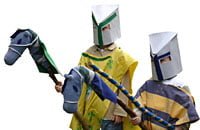Free shipping on USA orders over $129!

When I started homeschooling more than thirteen years ago, I used a unit study approach because I thought it was my only alternative to a traditional curriculum. At the end of that year I heard about Charlotte Mason and knew that the Charlotte Mason Method was the one I wanted to pursue.
Over the next few years I pondered what makes the difference between a unit study approach and the Charlotte Mason approach. It wasn’t until I read a couple of passages in Charlotte’s writings that I understood the distinction more fully.
In this part of our series comparing the various homeschooling methods, we’ll look at how Charlotte explained the difference between the Charlotte Mason Method and a unit study approach.
Forming Relations
As we mentioned in the first part of this series, Charlotte believed that true education consists of forming relations with God, with mankind, and with the universe around us. She was particularly emphatic that it was the child himself who should do the mental work of forming those relations.
Herein lies the first difference between Charlotte Mason and unit studies. With a unit study approach, it is the teacher who forms the relations and makes the connections for the child and then presents her findings. “The teacher has done it; he has selected the ideas, shewn the correlation of each with the other and the work is complete” (Vol. 6, p. 114).
In Volume 6 Charlotte gave an example of a unit study with Robinson Crusoe as the focal point (p. 115). The activities included
- Object Lessons on the sea, a ship from foreign parts, a life-boat, shell-fish, a cave, etc.
- Drawing Lessons on an oar, an anchor, a ship, a boat, etc.
- Building models of the seashore, of Robinson’s island, of Robinson’s house and pottery
- Reading passages from The Child’s Robinson Crusoe
- Reading passages from a general reader on the items mentioned in the object lessons
- Composing summary sentences as a group and have students copy this composition from the blackboard
- Arithmetic related to Robinson (no examples given)
- Singing and Recitation, for example, “I am the monarch of all I see,” etc.
In the typical unit study, the student depends on the teacher to show him how ideas are connected and related to each other. Charlotte wanted the student to form those relations himself, which she believed is a key to “owning” the idea.
Natural Connections
But didn’t Charlotte’s curriculum correlate certain subjects? Yes, Charlotte did often correlate history, geography, and literature for the same time period. But herein lies the second difference: Charlotte made a distinction between what she considered natural connections and forced, arbitrary connections.
In Charlotte’s schools “the co-ordination of studies is carefully regulated without any reference to the clash of ideas on the threshold or their combination into apperception masses; but solely with reference to the natural and inevitable co-ordination of certain subjects. Thus, in readings on the period of the Armada, we should not devote the contemporary arithmetic lessons to calculations as to the amount of food necessary to sustain the Spanish fleet, because this is an arbitrary and not an inherent connection; but we should read such history, travels, and literature as would make the Spanish Armada live in the mind” (Vol. 3, p. 231).
As outlined in the Forming Relations section above, a typical unit study tries to correlate every possible school subject around the chosen theme of the study. The Charlotte Mason approach limits itself to just those natural connections that are inevitable. For example, when studying a person or event in history, it naturally follows that the child will learn about the place in which that person lived or that event happened (geography). And if the child is using a good living book, he will most likely be exposed to the literature of that time period. Those three school subjects are inherently combined.
Now you know the two passages, in Volumes 3 and 6, that helped me figure out the difference between the Charlotte Mason Method and the unit study approach. I hope they will also be helpful to you.
